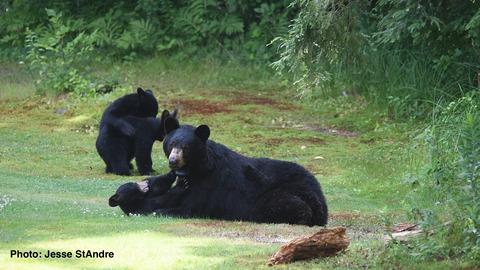当前位置:
X-MOL 学术
›
Anim. Conserv.
›
论文详情
Our official English website, www.x-mol.net, welcomes your feedback! (Note: you will need to create a separate account there.)
Response of female black bears to a high‐density road network and identification of long‐term road mitigation sites
Animal Conservation ( IF 3.4 ) Pub Date : 2020-07-11 , DOI: 10.1111/acv.12621 K. A. Zeller 1 , D. W. Wattles 2 , L. Conlee 3 , S. Destefano 1
Animal Conservation ( IF 3.4 ) Pub Date : 2020-07-11 , DOI: 10.1111/acv.12621 K. A. Zeller 1 , D. W. Wattles 2 , L. Conlee 3 , S. Destefano 1
Affiliation

|
Roads can result in negative effects on wildlife including habitat loss, behavioral avoidance, reduced survival, reproduction and gene flow. These road effects are especially pronounced for large mammals given their large home‐range requirements and low reproductive rates. To counteract these negative effects, road mitigation measures, such as underpasses and overpasses, are promoted; however, future landscape changes are rarely considered when selecting mitigation locations. We used GPS telemetry data on female American black bears Ursus americanus to examine their response to roads in Massachusetts, US. We compared bear road crossing frequency with a null crossing model derived from a correlated random walk, estimated road crossing movement speeds, and fit a road‐crossing resource selection function. We found that, though black bears crossed roads less than expected based on the null model, 10% of their observed steps, on average, crossed roads. We also found bears crossed roads at higher movement speeds than during other home‐range behaviors, and that bears preferred to cross smaller, less trafficked roads in areas with lower speed limits, less human development and more forest. We used the resource selection model to identify road segments for potential mitigation efforts and then used future human development projections to forecast future changes in these segments. We found a decrease of 15% in the length of suitable mitigation segments from 2019 to 2050. Given the sizeable investment in wildlife crossing structures and their longevity on the landscape, we recommend incorporating future projections into crossing site selection to ensure the long‐term viability of road mitigation efforts.
中文翻译:

母黑熊对高密度道路网的反应以及长期缓解道路的地点
道路可能对野生生物造成负面影响,包括栖息地丧失,行为规避,生存减少,繁殖和基因流动减少。这些道路效应对大型哺乳动物特别重要,因为它们对家畜的需求量大且繁殖率低。为了抵消这些负面影响,人们采取了诸如地下通道和高架桥之类的缓解道路措施;但是,在选择缓解地点时,很少考虑未来的景观变化。我们将GPS遥测数据用于美国雌性黑熊Ursus americanus检查他们对美国马萨诸塞州道路的反应。我们将熊的道路交叉频率与从相关的随机步行,估计的道路交叉移动速度得出的零交叉模型进行了比较,并拟合了道路交叉资源选择功能。我们发现,尽管黑熊的过马路少于基于零模型的预期,但平均观察到的步伐的10%是过马路。我们还发现,熊以比其他家庭范围行为更高的运动速度越过马路,并且熊更喜欢在速度限制较低,人类发展较少和森林更多的地区越过较小,人流量少的道路。我们使用资源选择模型来确定可进行缓解措施的路段,然后使用未来的人类发展预测来预测这些路段的未来变化。
更新日期:2020-07-11
中文翻译:

母黑熊对高密度道路网的反应以及长期缓解道路的地点
道路可能对野生生物造成负面影响,包括栖息地丧失,行为规避,生存减少,繁殖和基因流动减少。这些道路效应对大型哺乳动物特别重要,因为它们对家畜的需求量大且繁殖率低。为了抵消这些负面影响,人们采取了诸如地下通道和高架桥之类的缓解道路措施;但是,在选择缓解地点时,很少考虑未来的景观变化。我们将GPS遥测数据用于美国雌性黑熊Ursus americanus检查他们对美国马萨诸塞州道路的反应。我们将熊的道路交叉频率与从相关的随机步行,估计的道路交叉移动速度得出的零交叉模型进行了比较,并拟合了道路交叉资源选择功能。我们发现,尽管黑熊的过马路少于基于零模型的预期,但平均观察到的步伐的10%是过马路。我们还发现,熊以比其他家庭范围行为更高的运动速度越过马路,并且熊更喜欢在速度限制较低,人类发展较少和森林更多的地区越过较小,人流量少的道路。我们使用资源选择模型来确定可进行缓解措施的路段,然后使用未来的人类发展预测来预测这些路段的未来变化。


























 京公网安备 11010802027423号
京公网安备 11010802027423号